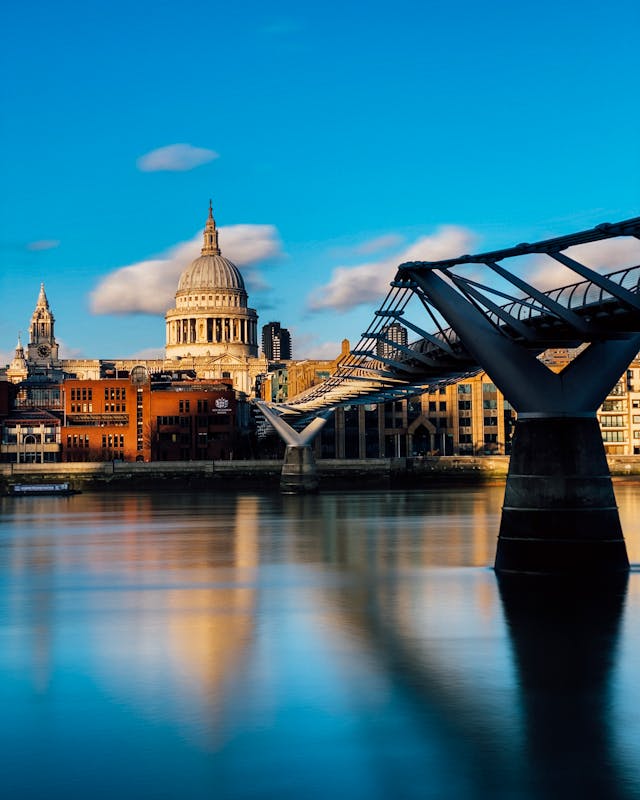St Paul’s Cathedral
A Testament to Faith, Resilience, and Architectural Brilliance
Standing majestically on Ludgate Hill, the highest point in the City of London, St. Paul’s Cathedral is more than just a place of worship; it’s a symbol of London’s endurance, a masterpiece of English Baroque architecture, and a living chronicle of British history. While its iconic dome and grand façade immediately capture the eye, the true magic of St. Paul’s lies in the stories etched into every stone and the centuries of human experience it has witnessed.
The cathedral we see today rose from the ashes of its predecessor, destroyed in the Great Fire of 1666. Sir Christopher Wren, tasked with its redesign, faced a monumental challenge: to create a structure that would not only serve as a place of worship but also stand as a beacon of hope for a city recovering from catastrophe. Wren’s genius is evident in every aspect of the cathedral, from its revolutionary three-dome design to the intricate mathematical proportions that govern its layout.
As you approach St. Paul’s, take a moment to appreciate the western façade. The twin towers, added as a compromise when Wren’s original single-tower design was rejected, create a harmonious balance that has become an integral part of London’s skyline. The portico, with its commanding Corinthian columns, draws the eye upward, preparing visitors for the awe-inspiring interior that awaits.
Stepping inside, one is immediately struck by the vastness of the space. The nave stretches out before you, its ceiling a masterpiece of trompe l’oeil painting that creates the illusion of elaborate stone carving. This optical illusion is just one example of Wren’s innovative approach to architecture and decoration.
The heart of St. Paul’s is undoubtedly its magnificent dome. Standing 111 meters high, it remains one of the largest cathedral domes in the world. The dome’s construction is a feat of engineering, consisting of three shells: an outer dome visible from the exterior, a concealed brick cone for structural support, and an inner dome visible from the cathedral floor. This ingenious design allows for the dome’s impressive height while maintaining perfect proportions within the cathedral.
For those willing to climb the 257 steps, the Whispering Gallery offers a unique experience. Here, a whisper against the wall can be heard clearly on the opposite side of the dome, a phenomenon that has delighted visitors for centuries. The gallery also provides a breathtaking view of the cathedral floor below, offering a new perspective on the grandeur of Wren’s design.
Throughout its history, St. Paul’s has been at the center of numerous significant events. It has hosted royal weddings, including that of Prince Charles and Lady Diana Spencer in 1981. It has been the site of state funerals for national heroes like Lord Nelson, the Duke of Wellington, and Sir Winston Churchill. During World War II, it became a symbol of British defiance. As bombs rained down on London during the Blitz, St. Paul’s stood tall, its survival amid the destruction serving as a powerful morale boost for the beleaguered city.
The cathedral is also a treasure trove of art and memorials. The American Memorial Chapel, rebuilt after World War II, is a touching tribute to the 28,000 Americans stationed in Britain who lost their lives during the conflict. The chapel’s roll of honor and its beautiful stained glass windows reflect the deep bonds forged between the two nations during wartime.
As you explore, pay attention to the variety of materials used in the cathedral’s construction. Portland stone dominates, chosen for its durability and light color. Purbeck marble adds elegance to columns and flooring, while gilt bronze brings a touch of splendor to decorative elements.
St. Paul’s Cathedral is not just a relic of the past; it continues to play a vital role in London’s spiritual and cultural life. It remains an active place of worship, hosts concerts and art installations, and continues to be a place where the nation gathers in times of celebration and mourning.
A visit to St. Paul’s is a journey through time, art, and spirituality. It’s a place where history comes alive, where architectural brilliance meets human aspiration, and where the spirit of London – resilient, innovative, and ever-evolving – is embodied in stone and glass. Whether you’re admiring its exterior from afar or exploring its hidden corners, St. Paul’s Cathedral offers an experience that resonates long after you’ve left its hallowed grounds.

